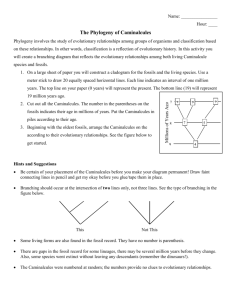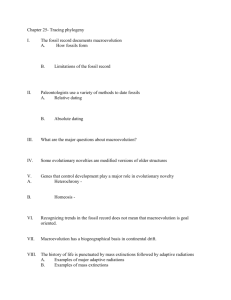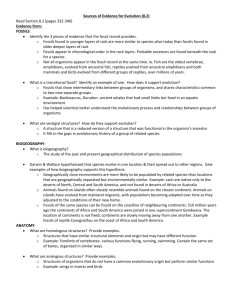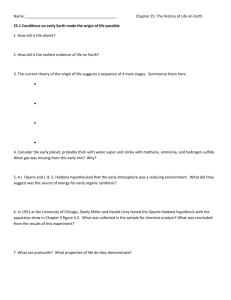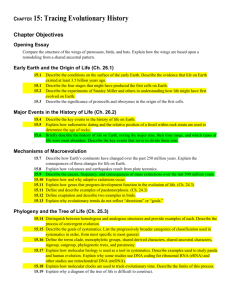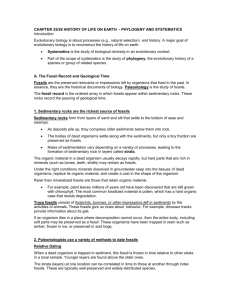Chapter 25 Phylogeny and Systematics The Fossil Record and
advertisement
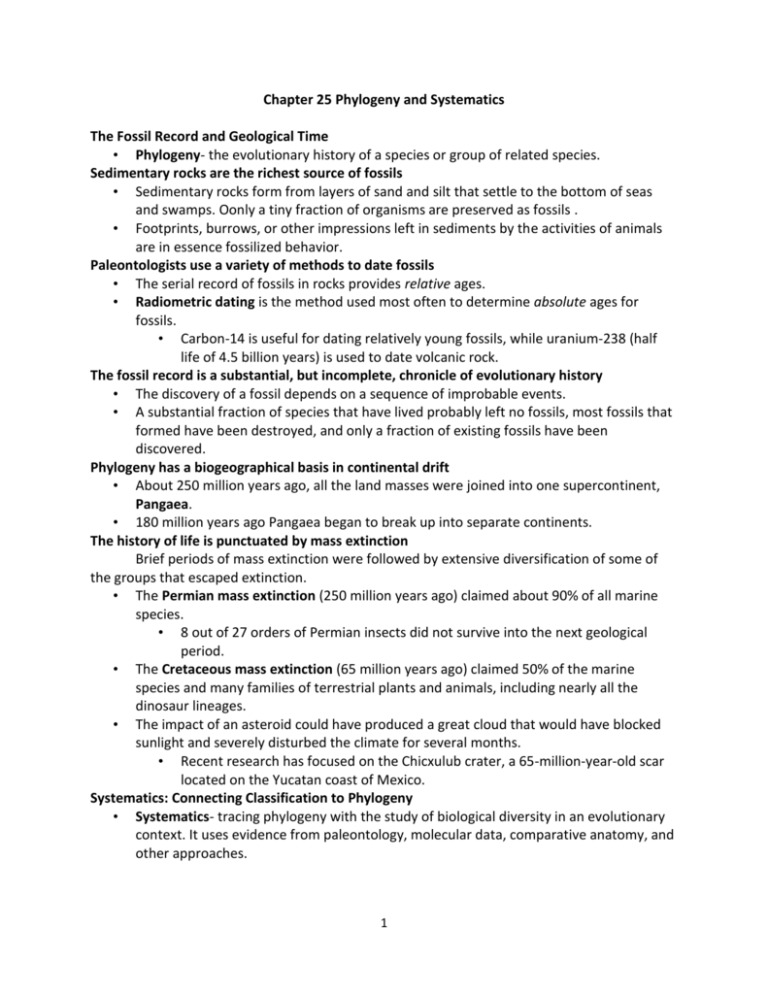
Chapter 25 Phylogeny and Systematics The Fossil Record and Geological Time • Phylogeny- the evolutionary history of a species or group of related species. Sedimentary rocks are the richest source of fossils • Sedimentary rocks form from layers of sand and silt that settle to the bottom of seas and swamps. Oonly a tiny fraction of organisms are preserved as fossils . • Footprints, burrows, or other impressions left in sediments by the activities of animals are in essence fossilized behavior. Paleontologists use a variety of methods to date fossils • The serial record of fossils in rocks provides relative ages. • Radiometric dating is the method used most often to determine absolute ages for fossils. • Carbon-14 is useful for dating relatively young fossils, while uranium-238 (half life of 4.5 billion years) is used to date volcanic rock. The fossil record is a substantial, but incomplete, chronicle of evolutionary history • The discovery of a fossil depends on a sequence of improbable events. • A substantial fraction of species that have lived probably left no fossils, most fossils that formed have been destroyed, and only a fraction of existing fossils have been discovered. Phylogeny has a biogeographical basis in continental drift • About 250 million years ago, all the land masses were joined into one supercontinent, Pangaea. • 180 million years ago Pangaea began to break up into separate continents. The history of life is punctuated by mass extinction Brief periods of mass extinction were followed by extensive diversification of some of the groups that escaped extinction. • The Permian mass extinction (250 million years ago) claimed about 90% of all marine species. • 8 out of 27 orders of Permian insects did not survive into the next geological period. • The Cretaceous mass extinction (65 million years ago) claimed 50% of the marine species and many families of terrestrial plants and animals, including nearly all the dinosaur lineages. • The impact of an asteroid could have produced a great cloud that would have blocked sunlight and severely disturbed the climate for several months. • Recent research has focused on the Chicxulub crater, a 65-million-year-old scar located on the Yucatan coast of Mexico. Systematics: Connecting Classification to Phylogeny • Systematics- tracing phylogeny with the study of biological diversity in an evolutionary context. It uses evidence from paleontology, molecular data, comparative anatomy, and other approaches. 1 Taxonomy employs a hierarchical system of classification • The Linnean system, first formally proposed by Linneaus in Systema naturae in the 18th century, has two main characteristics. • Each species has a two-part name. • Species are organized hierarchically into broader and broader groups of organisms. • A hierachical classification will group species into broader taxonomic categories. • Domain, kingdom, phylum, class, order, family, genus, species Kingdom: Animalia, Phylum: Chordata, Class: Mammalia, Order: Primates, Family: Hominidae, Genus: Homo, Species: sapiens Modern phylogenetic systematics is based on cladistic analysis • Determining which similarities between species are relevant to grouping the species in a clade is a challenge. • It is important to distinguish similarities that are based on shared ancestry or homology from those that are based on convergent evolution or analogy. • A cladogram presents the chronological sequence of branching during the evolutionary history of a set of organisms. Systematists can infer phylogeny from molecular evidence • Comparing genes and proteins among organisms provides insights into their evolutionary relationships. • The more recently two species have branched from a common ancestor, the more similar their DNA and amino acid sequences should be. • Most molecular systematics is based on a comparison of nucleotide sequences in DNA, or RNA. • The rates of change in DNA sequences varies from one part of the genome to another. • rRNA changes slowly • mtDNA evolves rapidly Molecular clocks may keep track of evolutionary time • Molecular clocks have been applied to place the origin of taxonomic groups in time. • Based on the observation that some regions of genomes evolve at constant rates. • For these regions, the number of nucleotide and amino acid substitutions between two lineages is proportional to the time that has elapsed since they branched. • Graph the number of amino acid or nucleotide differences against the times for a series of evolutionary events known from the fossil record. • The slope of the best line through these points represents the evolution rate of that molecular clock. • This rate can be used to estimate the absolute date of evolutionary events that have no fossil record. 2
